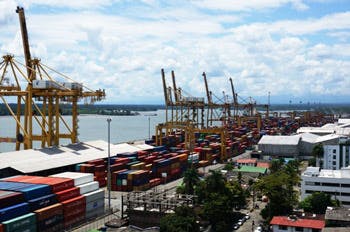Port Training in Colombia Provides Guidance for Importing U.S. Beef, Pork

The workshops in Colombia included a tour of facilities and a look at how U.S. meat is inspected as it enters the country
In an effort to clarify import inspection procedures at key ports in Colombia, USMEF teamed with the USA Poultry and Egg Export Council (USAPEEC) and the USDA Foreign Agricultural Service (FAS) to hold a series of workshops on food safety and customs inspections of U.S. meat products. Funding support for the workshops was provided by the Beef Checkoff Program and the Pork Checkoff.
To accommodate multiple shifts worked by port inspectors, two seminars were held in each of the three key Colombian ports: Cartagena de Indias, Barranquilla and Puerto Buenaventura. In addition to presentations given by FAS and USAPEEC, the workshop team offered sessions on a number of topics, including getting product from the plant to the port, U.S. beef quality and yield grading programs and frozen product attributes. The team also answered questions from inspectors about U.S. production practices – all the way from the farm through completion of the export documentation process.
Representing USMEF at the workshops were Dr. Nelson Huerta, director of technical services for Mexico, Central America and the Dominican Republic, and Cheyenne Dixon, manager of technical services.
“The strategy with these activities was to capitalize on established relationships with the government agencies of Colombia dealing with meat imports to clarify sensitive technical topics,” explained Huerta. “The ultimate objective is to increase awareness of USMEF and its regional activities as well as the quality and safety of U.S. red meats and variety meats exported to Colombia.”
At Buenaventura -- the most important and active entrance point for U.S. meat in the country – the team was given a tour and was able to witness the INVIMA (Colombia’s food safety agency) inspection processes on a load of U.S. pork trimmings.

Dr. Nelson Huerta provides input during the port workshop
“INVIMA walked us through an inspection of U.S. pork so we could observe and note the steps and see what they look for,” Dixon said. “In the past, it was unclear why certain products would get pulled or rejected at the ports. To be there in person and watch how the inspection process unfolds was very educational, and it allowed us to see the areas in which we may be able to help educate U.S. exporters as well as the local inspectors, to make the process more transparent and efficient.”
One of the biggest issues at the Colombian ports is rejection of stained boxes. According to government authorities, when this type of defect occurs, it often leads to a complete rejection.
USMEF addressed the issue, suggesting the inspectors address the issue on a box-by-box basis – instead of rejecting the entire load based on the condition of a few boxes. This involved a discussion on why a small number of boxes with moisture or blood purge don’t necessarily indicate that the whole load experienced a break in cold chain -- such as purge occurring in chilled product before freezing in the United States. A dialogue also took place on dusty boxes caused by dirty containers, an issue that frequently results in Colombia rejecting U.S. products.
“The seminars were very well-received by FAS and Colombian authorities and we are ready to follow them up in future opportunities,” Huerta said.

Buenaventura is the active entrance point for U.S. meat in Colombia
Follow-up discussions were held, with input from USMEF and FAS, along with INVIMA, ICA (APHIS equivalent) and the customs agency DIAN.
“During my talks I put special emphasis on USDA beef quality grading and branding programs using Prime and Choice grades, and how the beef quality is standardized in the U.S.,” Huerta said. “We clarified beef branding, verified processes, and other AMS roles in USDA. We emphasized that regardless of the cut, any Prime or Choice beef is tariff-free according to the FTA language.”
This is the second year that USMEF and FAS have held the port seminars. By partnering this year, USMEF and USAPEEC were each able to separately address their specific points of concern with the import processes, making the inspectors more knowledgeable on the U.S. meat and poultry industries and differences between the two. As noted by one attendee, traveling to these port cities sends a positive signal to the port inspectors. It shows that the U.S. industry takes their concerns and questions seriously and is very interested in building a strong communication channel that makes the import of U.S. meat products a smoother process.
